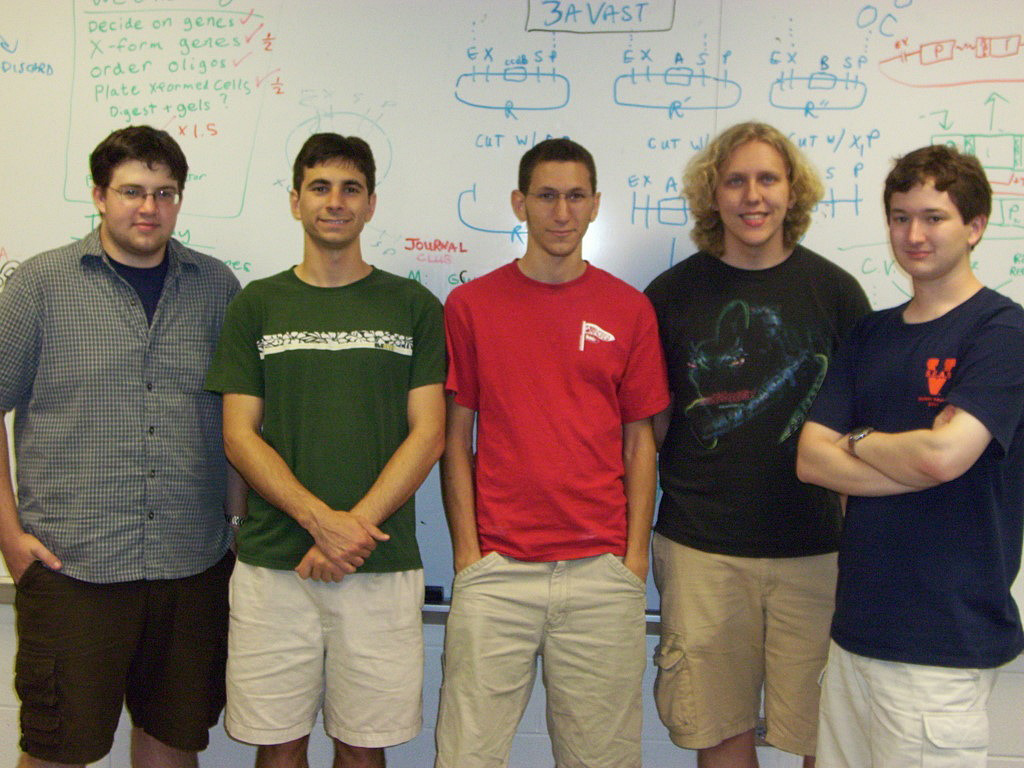February 12, 2009 — Synthetic biology is a newly emerging field with less than a dozen dedicated graduate programs nationwide. But this lack of established curriculum hasn't discouraged the Virginia Genetically Engineered Machine team, an interdisciplinary group of resourceful and ambitious undergraduate students at U.Va.
The VGEM team is a student-run research group that has been diligently working to institute synthetic biology as a vital research area at U.Va. This year, they created a new "Biological Systems Design" seminar, won a bronze medal from the International Genetically Engineered Machine competition and made some significant research contributions to the field.
Synthetic biologists use "Biobricks," which are standardized building blocks — DNA strands with functions that have been identified and categorized — to engineer unique capabilities into existing organisms. The 2007 VGEM team, for instance, worked to redesign the bacteria E. Coli so that it would produce biofuel.
Dan Tarjan, the 2008 VGEM team's spokesperson, noted that since it's such a new field, the current tools available in synthetic biology are fairly rudimentary and the process of creating a new biological system is very tedious, and uses a trial-and-error approach.
With this in mind, they developed a transcription attenuator to enable more precise control of gene expression. The group will test this approach on a real-world application. They have ongoing plans to modify E. Coli so that it produces a plastic material that is not derived from fossil fuels, and thus sustainable.
The overarching theme for this year's team was to expand the tools available to researchers so that they can tackle more complex problems, Tarjan said.
The group also worked on Biobrick "placeholders" that will serve to make it easier to assemble complex, composite pieces of DNA consisting of several BioBrick parts. The placeholders the team developed will be especially helpful for cases when researchers want to construct essentially the same composite part with only one member part changing between the different composites.
Finally, the team identified two new fluorescent proteins that will be entered into the MIT Registry of Standard Biological Parts[link to: http://partsregistry.org/Main_Page]. In keeping with U.Va. tradition, the proteins are blue and orange.
The team presented its findings at the 2008 International Genetically Engineered Machine conference, which attracted 84 teams from 21 different countries, and won a bronze medal for its efforts.
The VGEM team is already raising funds and recruiting members for next year. Tarjan hopes to further establish VGEM at U.Va., making it a year-round activity rather than just a summer project.
"This is a unique opportunity for undergrads to shape their own research project," Tarjan said.
The 2008 VGEM team includes Tarjan (biology and computer science), George Washington (chemical engineering and computer science), Patrick Gildea (chemical engineering and computer science), Eyad Lababidi (electrical engineering) and Brandon Freshcorn (biomedical engineering). Faculty advising the team include Erik Fernandez (chemical engineering), Jason Papin (biomedical engineering) and Michael Timko (biology).
The VGEM team is a student-run research group that has been diligently working to institute synthetic biology as a vital research area at U.Va. This year, they created a new "Biological Systems Design" seminar, won a bronze medal from the International Genetically Engineered Machine competition and made some significant research contributions to the field.
Synthetic biologists use "Biobricks," which are standardized building blocks — DNA strands with functions that have been identified and categorized — to engineer unique capabilities into existing organisms. The 2007 VGEM team, for instance, worked to redesign the bacteria E. Coli so that it would produce biofuel.
Dan Tarjan, the 2008 VGEM team's spokesperson, noted that since it's such a new field, the current tools available in synthetic biology are fairly rudimentary and the process of creating a new biological system is very tedious, and uses a trial-and-error approach.
With this in mind, they developed a transcription attenuator to enable more precise control of gene expression. The group will test this approach on a real-world application. They have ongoing plans to modify E. Coli so that it produces a plastic material that is not derived from fossil fuels, and thus sustainable.
The overarching theme for this year's team was to expand the tools available to researchers so that they can tackle more complex problems, Tarjan said.
The group also worked on Biobrick "placeholders" that will serve to make it easier to assemble complex, composite pieces of DNA consisting of several BioBrick parts. The placeholders the team developed will be especially helpful for cases when researchers want to construct essentially the same composite part with only one member part changing between the different composites.
Finally, the team identified two new fluorescent proteins that will be entered into the MIT Registry of Standard Biological Parts[link to: http://partsregistry.org/Main_Page]. In keeping with U.Va. tradition, the proteins are blue and orange.
The team presented its findings at the 2008 International Genetically Engineered Machine conference, which attracted 84 teams from 21 different countries, and won a bronze medal for its efforts.
The VGEM team is already raising funds and recruiting members for next year. Tarjan hopes to further establish VGEM at U.Va., making it a year-round activity rather than just a summer project.
"This is a unique opportunity for undergrads to shape their own research project," Tarjan said.
The 2008 VGEM team includes Tarjan (biology and computer science), George Washington (chemical engineering and computer science), Patrick Gildea (chemical engineering and computer science), Eyad Lababidi (electrical engineering) and Brandon Freshcorn (biomedical engineering). Faculty advising the team include Erik Fernandez (chemical engineering), Jason Papin (biomedical engineering) and Michael Timko (biology).
Media Contact
Article Information
February 12, 2009
/content/ambitious-undergraduate-research-breaks-new-ground

